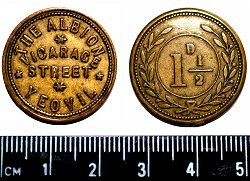The history of yeovil's pubs
PUBS HOME PAGE |
PUBS INTRODUCTION |
PUBS BY NAME |
BEERHOUSES |
albion inn
10 Vicarage Street
 Albion
is the oldest
known name for
the island of
Great Britain
and derives from
the Proto-Celtic
Albi̯en. The
Albion Inn
(marked 'B' on
the 1886 map
here) was an old
pub for many
years almost
opposite
Frederick Place.
Albion
is the oldest
known name for
the island of
Great Britain
and derives from
the Proto-Celtic
Albi̯en. The
Albion Inn
(marked 'B' on
the 1886 map
here) was an old
pub for many
years almost
opposite
Frederick Place.
It was rebuilt in 1937 by the brewery as a corner site public house at the junction of Vincent Street with Vicarage Street after Vincent Street was built.
The rebuilt Albion photographed below was constructed of ashlar under a slate roof with squared hood moulding over a mullioned window at first floor and a similar, continuous hood moulding over the squared entrance (with mock-Tudor head to the doorway) and side windows.
|
|
This is a public house 'check' or trade token from my collection, probably issued in the late nineteenth or early twentieth century, from the Albion Inn in for the value 1½d. Made of brass, it is just under 24mm in diameter and is 1.4mm thick. At this time 1½d would have bought a pint or two of local cider or ale.
|
Public house 'checks' were frequently used in pub games, such as skittles or quoits where, for instance, players would 'chip in' a check to the 'kitty' which would be won by the winning team to redeem at the bar. By issuing checks a landlord could guarantee they would be spent in his establishment only.
See also Yeovil Trade Tokens and Checks
By the 1890s the Albion Inn was a tied house of the Royal Osborne Brewery, with a long lease owned by Earle Vincent. When Vincent died in 1893 his estate was sold off the following year which included "the Albion Inn at Vicarage Street, at £22 (about £2,200 at today's value), and rented by Mr Hubert Beare."
The Albion finally closed on 27 March 1983 and demolition began on 30 May 1983, as part of the wholesale redevelopment of the area that became the Quedam shopping centre.
![]()
The first licensee, William Patten, was a 40-year old cooper living in Vicarage Street in 1841 but is recorded as the licensee in 1842. The second licensee listed below in Hunt & Co's 1850 Directory and in the 1851 census as a harness maker and innkeeper was actually William's son, also called William, who was listed as a 14 year old apprentice saddler in the 1841 census. In the 1851 census he is listed as licensee of the Albion but he died that year and the license was taken over for a while by his widow, Elizabeth.
The Pattens were followed by Joseph, or Josiah, Farthing from Worcester who was licensee for some fifteen years. In 1851 He was listed as a tailor living on Reckleford with his first wife, Mary, and their children. Within a couple of years Mary died and Joseph remarried. But within a couple of years he too died and was succeeded briefly by his widow, Hannah.
I could find no other records for Joseph Facey who was listed as licensee in 1875.
Yeovil-born Henry Oxley then took up the license for a few years. Henry had been a Private in the Royal Marine Artillery but by 1875, following his retirement from the army, he was running the Albion at the age of 36. He was still licensee in 1881 but seems to disappear from the records after this date. He was followed for a brief spell by William Glover, a fishmonger before, during and after his period as licensee.
The next licensee was Hubert Beare (born 1833 in Yeovil), an experienced licensee from a pub-running dynasty. His father, James, had run the Beehive in Huish and was its first licensee in 1841. His widow, Joanna, is seen to have taken over the license by 1851.
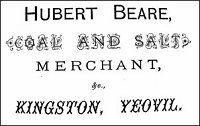 Their son
Hubert, a
foreman in a
coal yard in
1861 but listed
as a coal and
salt merchant by
1866, was
licensee of the
Beehive from at
least 1866 until
at least 1875
but by 1895 was
licensee of the
Anchor Inn in
Vicarage Street
where he only
stayed a few
years because by
1898 he was
licensee at the
Albion Inn.
Their son
Hubert, a
foreman in a
coal yard in
1861 but listed
as a coal and
salt merchant by
1866, was
licensee of the
Beehive from at
least 1866 until
at least 1875
but by 1895 was
licensee of the
Anchor Inn in
Vicarage Street
where he only
stayed a few
years because by
1898 he was
licensee at the
Albion Inn.
Hubert doesn't seem to have advertised his presence as the Albion's landlord with advertisements, but he did place a good number extolling his business as a Coal and Salt Merchant. Hubert's son, James, was licensee of the Quicksilver Mail in the 1910's.
Hubert didn't stay long at the Albion and by 1891 he was followed throughout the next decade by a series of short-term licensees. Robert James Parsons was licensee by 1911 and both he and his wife, Elizabeth, were listed as innkeepers in the 1911 census. He had been born in Ilminster in 1877 but had lived in London where his daughter, Doris, had been born in 1903 but the family had then returned to Somerset. Robert remained licensee of the Albion until 1938.
Arthur Rankin, who had previously been licensee of the Heart of Oak in Westminster Street, was licensee of the Albion from around 1947 to about 1954.
gallery
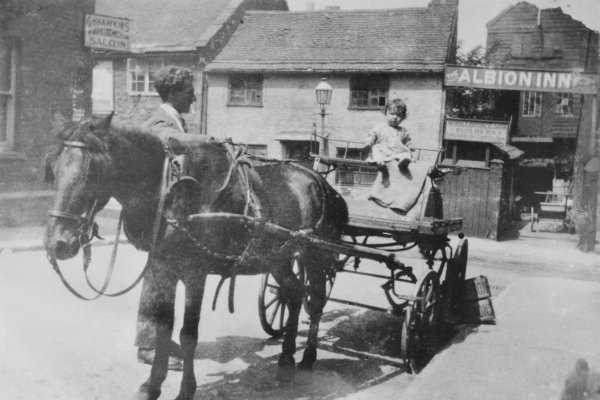
Courtesy of
Tony Robins
This photograph was taken from Frederick Place about 1935 and looks across Vicarage Street. The sign of the Albion Inn is over the inn's yard, the inn itself was off-photo to the right but was completely rebuilt by the brewery two years later, in 1937. Tony Robins' brother, Cliff, is sitting in the cart aged about two and wearing a dress - as was the fashion at the time. Tony's dad, Harold Robins, is holding the horse. Tony's granddad, Nat Robins, had a shop on the eastern corner of Frederick Place, opposite the inn, again just off the photograph to the right. The yard under the sign was W Walbridge & sons, later Perry's, builders yard. The sign at top left is for GH Hawkins' Fish & Chip Saloon.

Courtesy of
David Collard
A colourised photograph by Walter S Rendell & Son, probably taken in the 1940s, of the annual outing of the Albion's darts and skittles teams.
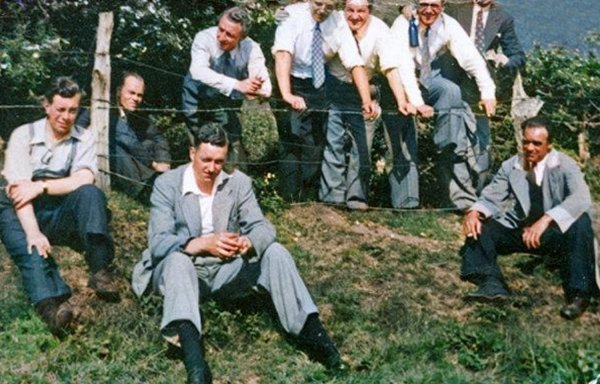
Courtesy of
David Collard
Another colourised photograph of an annual outing of regulars of the Albion, again probably dating to the 1940s. David's father, Edward Collard, is the chap in the smart suit sitting in the foreground just left of centre. What is perhaps unusual for a pub outing, is that only one bottle of beer is visible in the photograph.
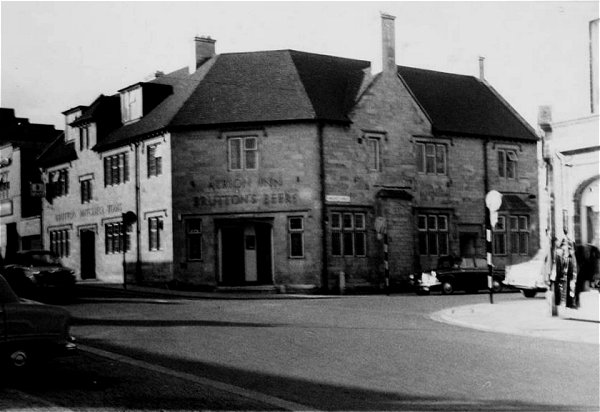
Photographed in 1960 by Charrington & Co Ltd's surveyors as part of a 'stocktaking' exercise of photographing Brutton's pubs prior to the brewery takeover.
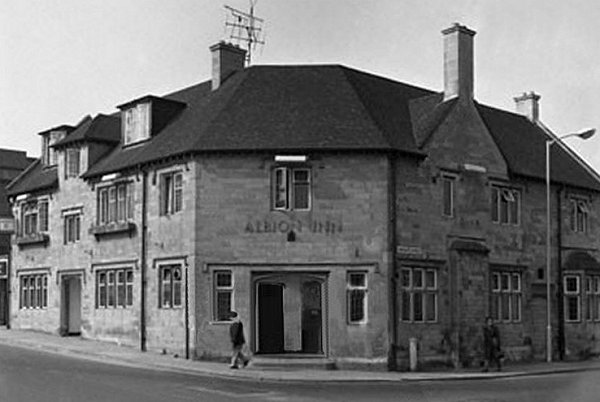
The Albion Inn, photographed about 1975.
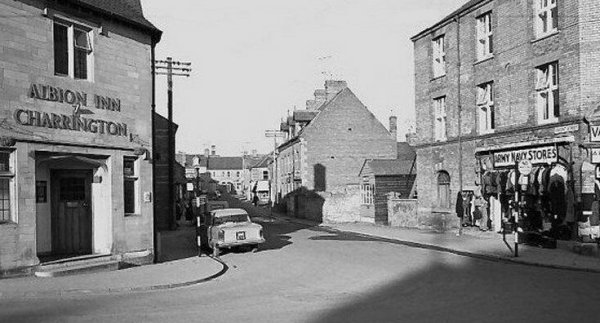
The Albion Inn on the corner of Vicarage Street (in the foreground) and Vincent Street (with the car in it), photographed in the mid-1960s.
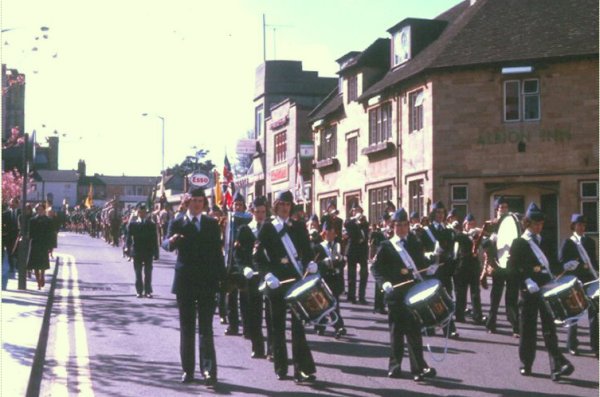
The Boy's Brigade marching along Vicarage Street during the mid-1970's.
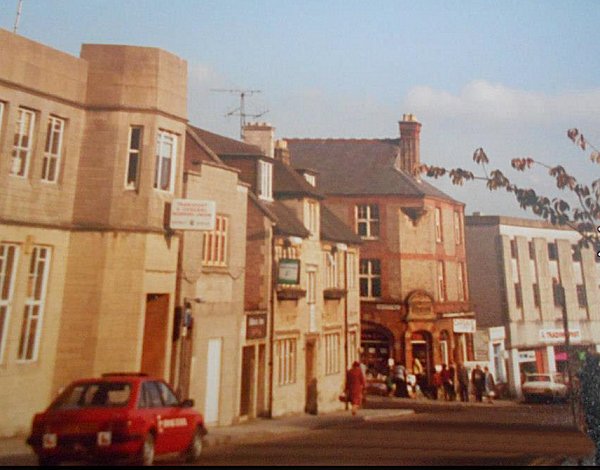
Courtesy of
Helen Angel
Extance
The T&GWU offices at left, the Albion Inn, the entrance to Vincent Street then the old Army & Navy Stores building. Photographed from Vicarage Street shortly before demolition in 1983.
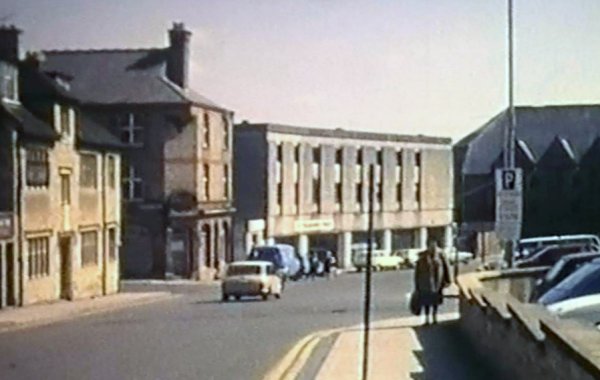
Looking eastwards towards the bend in Vicarage Street in the late 1970s. At extreme left is the Albion Inn, then the junction of Vincent Street, on the opposite corner was the building that had been the Army & Navy Stores. The modern building at centre had been Neal & Williams Ltd glove factory which, during the Second World War had been the venue for the Yeovil War Workers Club. I'm not sure if the building was completely rebuilt after the war or just re-fronted. Next was the entrance to the Council's Town Yard and finally, at right, the Methodist church - the only building in this scene that remains today.
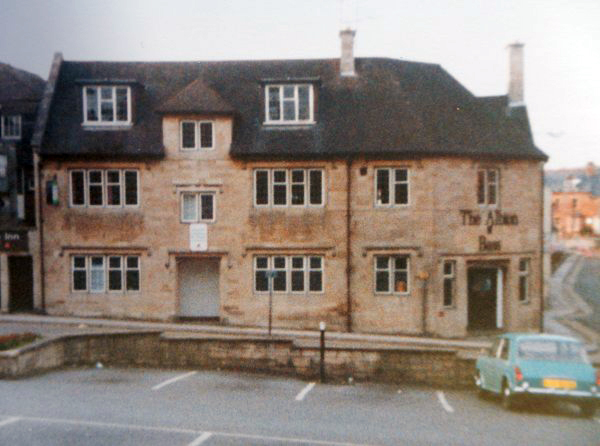
Courtesy of
Vivien and John
Cornelius
The Albion, photographed in 1982 from the Vicarage Street car park.
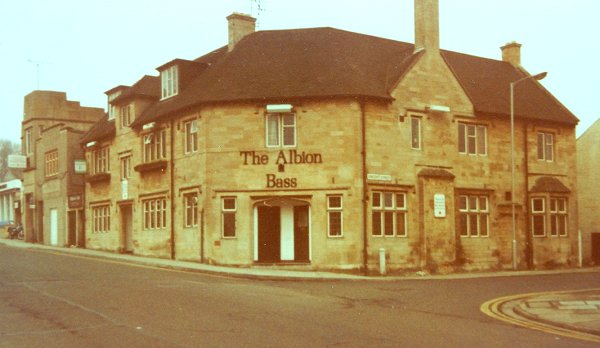
Courtesy of
Colin Haine
.... and again, photographed in 1982.
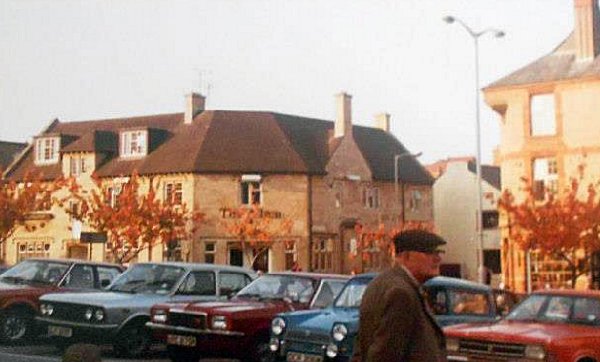
Courtesy of
Helen Extance
Looking across the car park towards the Albion, shortly before demolition in 1982.
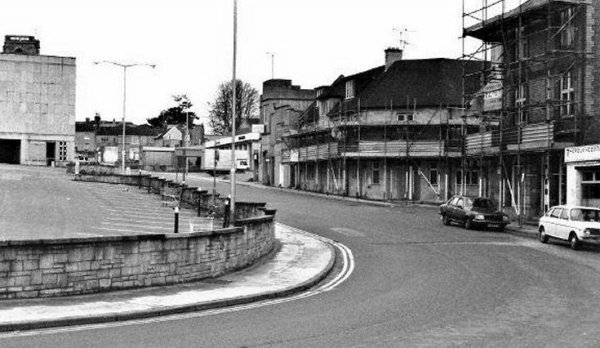
Looking down Vicarage Street with the Albion Inn, right of centre, scaffolded and awaiting demolition in 1983.
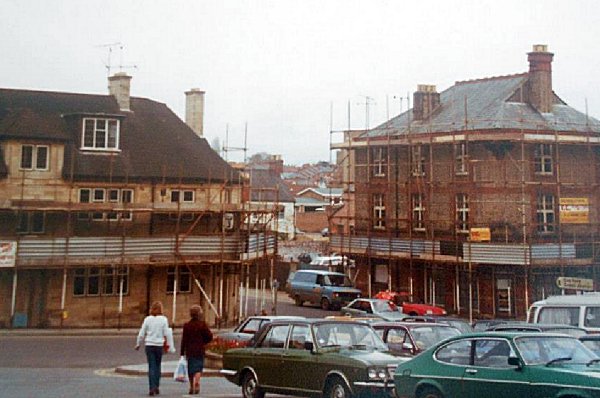
Courtesy of
Helen Extance
.... and seen from the car park (at left in the previous photograph) in 1983.
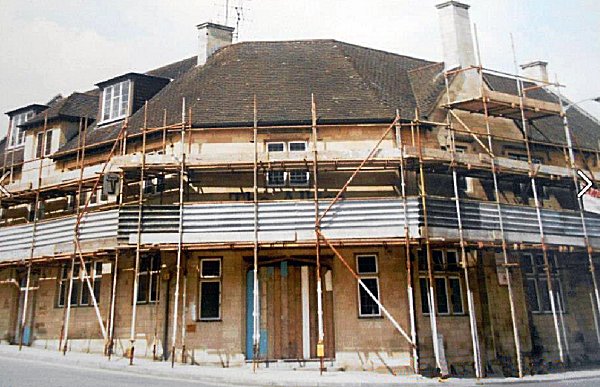
Courtesy of
Helen Extance
The Albion - all boarded up and awaiting demolition in 1983.
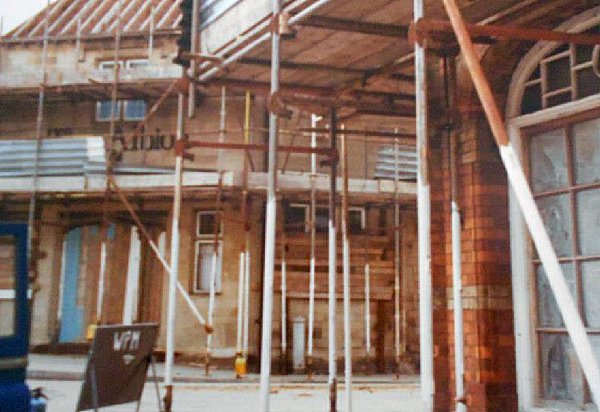
Courtesy of
Helen Extance
Close-up of the scaffolded Albion seen from across Vincent Street in 1983.
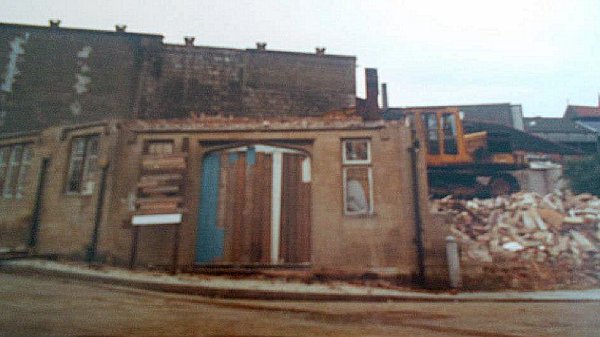
Courtesy of
Helen Extance
Demolition begins. 1983.
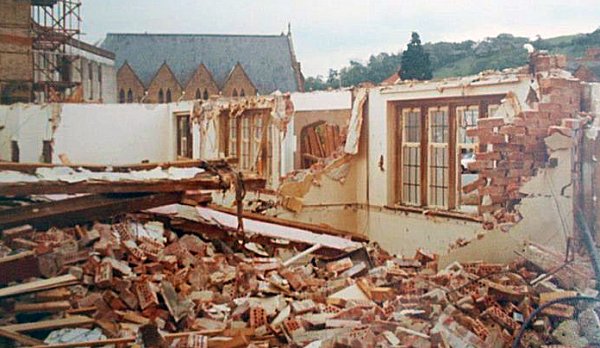
Courtesy of
Helen Extance
.... and seen from inside in 1983.
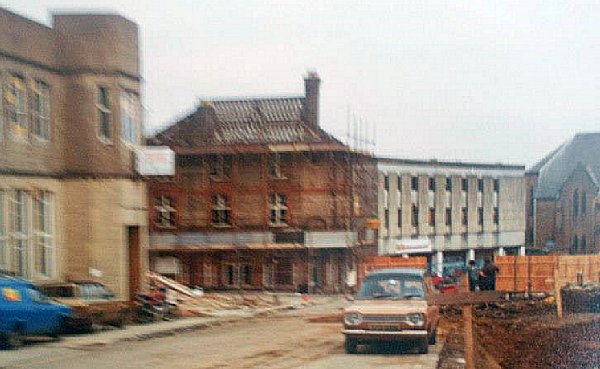
Courtesy of
Helen Extance
.... and there it was - gone!!!
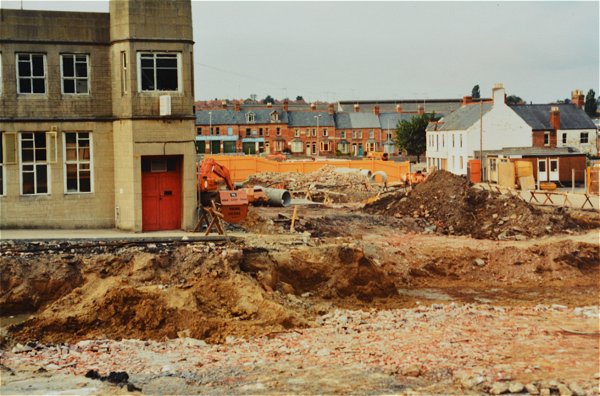
Courtesy of
Chris Rendell
The footprint of the Albion Inn seen from what had been the Vicarage Street car park.
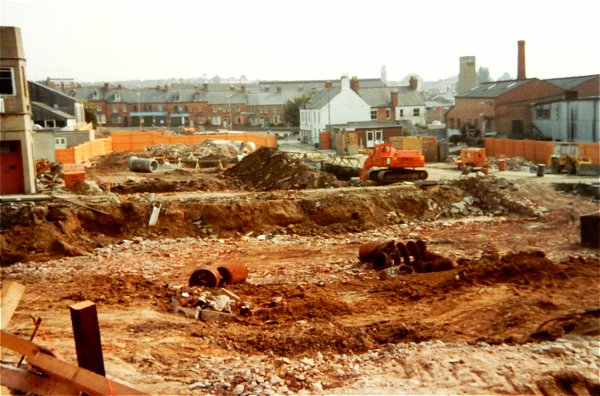
Courtesy of
Colin Haine
.... and photographed from Lipton's Arch, Frederick Place, in 1984. Both the Albion Inn and the old Army & Navy store on the opposite corner of Vincent Street have been flattened.
licensees
1842 –
William Patten –
Retailer of Beer
(Pigot’s 1842-4
Directory)
1850 – William
Patten – Beer
Retailer (Hunt &
Co's 1850
Directory) -
this was William
junior.
1851 – William
Patten – Harness
Maker & Inn
Keeper (1851
census)
1852 – Elizabeth
Patten –
Retailer of Beer
(Slater's 1852/3
Directory)
1859 – Joseph
Farthing
– applied for Spirit license
(Petty
Sessions) as
Albion
1861 – Joseph
Farthing –
Publican (1861
census) listed
as Albion Inn.
1861 – Josia
Farthing
(Kelly's 1861
Directory)
1866 – Josia
Farthing
(Kelly's 1866
Directory)
1871 – Hannah
Farthing (60
year old widow
of Joseph above)
- Inn Keeper
(1871 census)
1875 – Joseph
Facey (Kelly's
1875 Directory -
Hotels & Inns)
1875 – Henry
Oxley (Whitby's
Yeovil Almanack
Advertiser 1875)
listed at 15
Vicarage Street
1881 – Henry
Oxley -
Pensioner and
Publican (1881
census) listed
as Albion Inn
1882 – Josia
Farthing
(Kelly's 1882
Directory) This
is probably a
mistake on the
part of Kelly
as Josia had died
and didn't have
a son by this
name.
1890 – William
Glover (Kelly's
1890 Directory)
listed at 10
Vicarage Street
1891 – William
Glover –
Fishmonger &
Publican (1891
census) listed
as Albion Inn.
1898 – Hubert
Beare (Whitby's
Yeovil Almanack
Advertiser 1898)
listed at 10
Vicarage Street
1894 – Hubert
Beare -
rented at £22
per annum (Sale
of Earle
Vincent's
estate)
1900 – Hubert
Beare (Whitby's
Yeovil Almanack
Advertiser 1900)
listed at 10
Vicarage Street
1901 – George
Hales – Publican
(1901 census)
pub not named
1903 – F Brown
(Whitby's Yeovil
Almanack
Advertiser 1903)
listed at 10
Vicarage Street.
Brown is
probably the
same F Brown who
was licensee of
the King's Arms
in Silver Street
in 1907.
1907 – J Connock
(Collin's 1907
Yeovil
Directory)
1911 – Robert
Parsons - Inn
Keeper (1911
census)
1911 – Robert J
Parsons
(Whitby's Yeovil
Almanack
Advertiser 1911)
1916 – Robert J
Parsons
(Whitby's Yeovil
Almanack
Advertiser 1916)
1919 – Robert
James Parsons
(Kelly’s 1919
Directory)
1923 – Robert
Parsons (Kelly’s
1923 Directory)
listed as Albion
PH
1936 – RJ
Parsons (1936
Yeovil
Directory)
listed as Albion
Inn
1938 – RJ
Parsons (1938
Yeovil
Directory)
listed as Albion
Inn
1939 – John
Smith (Kelly’s
1939 Directory)
listed as Albion
PH
1947 – A Rankin
(1947 Yeovil
Directory)
listed as Albion
Inn
1949 – A Rankin
(Kelly’s 1949
Directory)
listed as Albion
Inn
1951 – A Rankin
(1951 Yeovil
Directory)
listed as Albion
Inn
1954 – A Rankin
(1954 Yeovil
Directory)
listed as Albion
Inn
1957 – FW Gray
(1957 Yeovil
Directory)
listed as Albion
Inn
1965 – Licensee
not named (1965
Yeovil
Directory)
listed as Albion
Inn
1968 – Licensee
not named
(Kelly’s 1968
Directory)
listed as Albion
Inn
1969 – Licensee
not named
(Kelly’s 1969
Directory)
listed as Albion
Inn
1970 – Licensee
not named
(Kelly’s 1970
Directory)
listed as Albion
Inn
1971 – Licensee
not named
(Kelly’s 1971
Directory)
listed as Albion
Inn
1972 – Licensee
not named
(Kelly’s 1972
Directory)
listed as Albion
Inn
1973 – Licensee
not named
(Kelly’s 1973
Directory)
listed as Albion
Inn
1974 – Licensee
not named (1974
Yeovil
Directory)
listed as Albion
Inn
